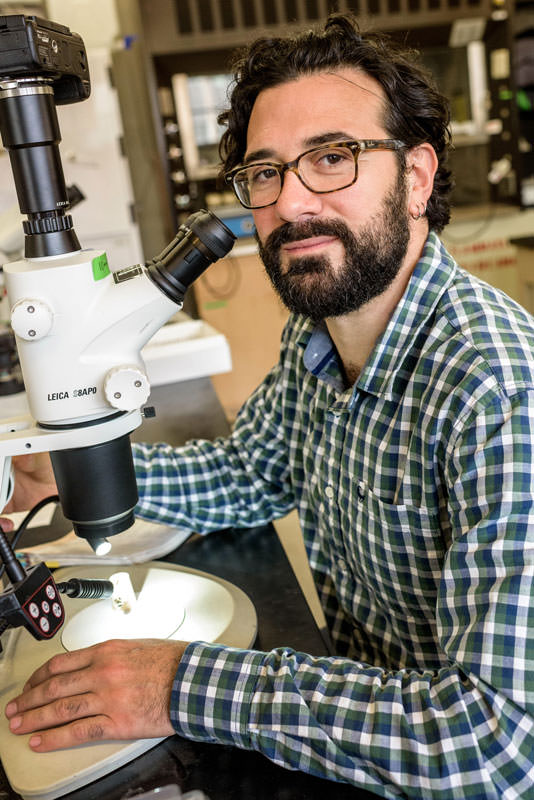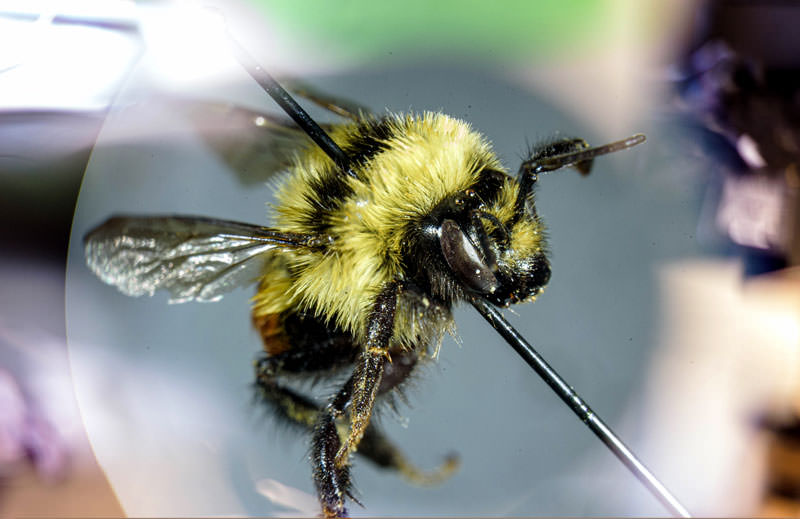University of Nevada, Reno is a hub for pollinator research.
In the Leonard Lab at the University of Nevada, Reno’s Fleischmann Agriculture Building, I look through a microscope at an Osmia densa, or mason bee, marveling at its intricate hairs coated in flecks of pollen.
The solitary bee (it does not live in a hive like the well-known honey bee, but instead nests alone in holes or tunnels in trees left by burrowing beetles) is native to the Great Basin region. It’s one of the hundreds of indigenous bee species that a team of UNR researchers is currently studying thanks to a three-year grant from the National Science Foundation.

Spearheaded by associate professor and published researcher Anne Leonard, UNR’s bee lab is responsible for conducting painstaking research on the region’s pollinators (imagine counting hundreds of thousands of pollen particles under a microscope).
The importance of this work is clear: Pollinators — including feral and managed honey bee colonies and wild native species — are responsible for helping three-fourths of the world’s flowering plants reproduce and about 35 percent of the world’s food crops.
While there is ample research on the European honey bee, which was introduced to North America in 1622, there is far less research on native bees, of which there are roughly 3,500 species in the United States alone.
One study found that wild pollinators helped increase yield in 41 crops by twice that facilitated by honey bees. Another discovered that native bees are responsible for 90 percent of the pollination of watermelons. As for tomatoes? Honey bees aren’t large enough to successfully pollinate them, and the job falls to the beefier bumble bee.
In the Great Basin alone, there are an estimated 800 native bee species, and in an effort that started last summer, the team of researchers at UNR is working to better understand the relationship between these bees and native wildflowers.
The work has implications for ecosystem conservation, bee health, and even the availability of bees to pollinate our food.
Balanced Diet
This past summer, Anthony Vaudo and a team of fellow UNR researchers spent several weeks in the Sierra — specifically in meadows near Lake Van Norden and the Mt. Rose Wilderness — collecting native bee species from a variety of wildflowers.
They observed the bees alighting on the dense pink flower clusters of the pussy-paw; the tall, tapering, purple flowers of the lupine; and the large yellow flower head of the arnica, and learned, in great detail, about a buzzing world that most of us overlook.

The researchers are trying to understand whether the nutritional content of pollen affects bee foraging behavior. Out in the field, they take note of what varieties of plant species the different native bee species visit, and back in the lab, they brush off and analyze pollen from the collected bee specimens to analyze and determine what flower each came from and its nutritional content.
“We are trying to figure out why certain bees visit certain flowers but not others,” Vaudo says. “I believe one reason is because they choose pollen that meets their personal nutritional needs.”
Though the researchers are only in their first of three years of research (but have collected nearly 50 species of native bees), Vaudo says it does appear that bees differentiate flowers across the landscape based on the pollen. Analyzing the network of wildflowers that each bee species visits helps them to better understand the biodiversity of the ecosystem, which has applications in conservation.

“By understanding the ways that bees utilize their host plants, we know how to keep them healthy, so if we want to protect them, we know what nutrients they need and what flowers to plant to protect certain species,” Vaudo explains. “At the same time, we know what the pollinators of those plants that we want to protect are. By understanding the biodiversity of those communities, we can approach conservation from the perspective of keeping that ecosystem stable.”
The study of pollination ecology is important not just for the stability of ecosystems, but for food security and agricultural pollination, too.
“The majority of bee research has to do with honey bees,” Vaudo notes, “but now we are really switching to focusing on native bees — what their diversity is, how they keep the ecosystem together, how we can protect them, and also the use of native bee fauna for pollination services when managed beekeeping might be struggling.”
Close Quarters
From his office computer in the Fleischmann Agriculture Building, Ph.D. candidate Jacob Francis identifies and maps thousands upon thousands of wildflowers on high-resolution drone images taken along State Route 89 outside of Truckee.
“We build huge maps of flowers and measure the amounts of pollen and nectar they make and the quality of those things,” Francis explains. “We are looking at the types of rewards a plant produces and how their spatial arrangement impacts whether or not they interact with each other and how they interact with each other.”
By “interact,” Francis means the connection between plants as bees fly from flower to flower foraging.
“Plants are competing with each other to attract pollinators, but they also might be facilitating each other,” he adds.
In a condensed version of this research, fellow Ph.D. candidate Devon Picklum is studying how two similar wildflowers deal with sharing the same species of bumble bee pollinator.
“They are similar in their overall appearance, live in a very specialized habitat, bloom at the same time, and only provide pollen as a reward, so there is no nectar,” Picklum explains.
“We understand that diversity is really important for the stability of ecosystems, for animals and plants living together, but we don’t really understand how they deal with the negative side of being a plant that shares pollinators and potentially gets a decrease in the quality and quantity of their pollen due to this.”
This sort of plant-pollinator research provides vital information on conservation, bee health, and how plants co-exist in their ecosystems, Picklum notes.
For UNR’s ecologists, the research has one more very important application: education.
“We are hoping to take our data and findings and visit schools and run different outreach programs to teach our future scientists,” Vaudo says.
For Francis, this research also serves as a jumping-off point for conversations about supporting our native bee populations.
“We are losing bee species. There is a bee species in Northern California that hasn’t been seen for 20 years,” he says. “There are a lot of things leading to that, but the easiest one for us to address as gardeners and farmers is to make sure that we leave food for bees to eat, and that is by having flowers that produce pollen and nectar even after your crop is done blooming.”
Claire McArthur is a freelance writer who has a newfound respect for the pollination work of bees — and the incredible work that UNR’s ecologists are putting in every day to better understand these important insects.


